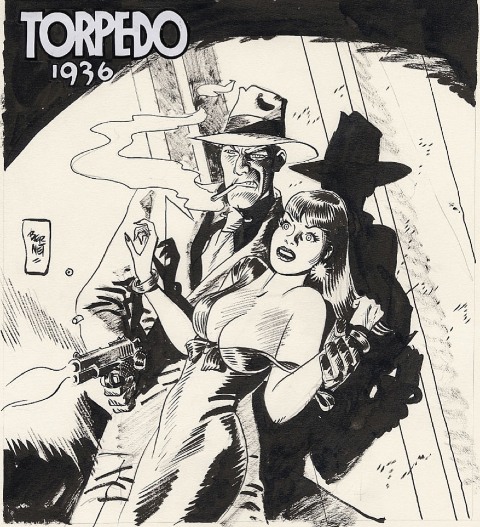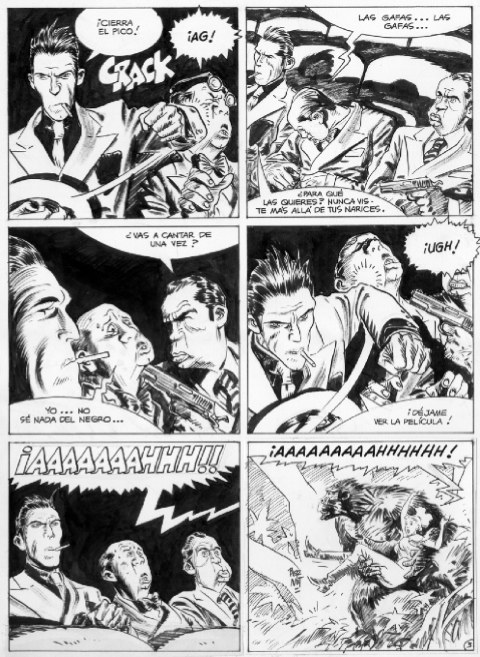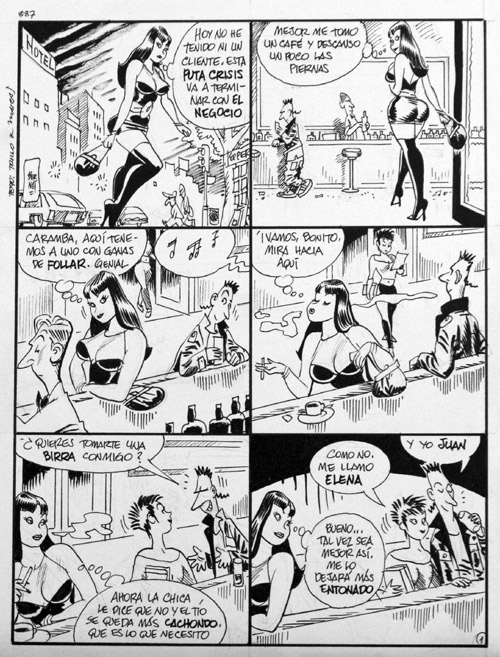Jordi Bernet:
Black Ink, Black Humour

Better late than never, acclaim in America for one of Spain’s most prolific and distinctive comics illustrators has finally come, largely thanks to his electrifying renditions of DC Comics’ scarred gunman Jonah Hex, as well as a recent story arc on Scott Snyder’s American Vampire. Before this, Jordi Bernet has had a long and fruitful career, not only in his native Spain but across Europe, including Britain. His magnum opus, with writer Enrique Sanchez Abuli, is the venal killer-for-hire Torpedo, cover-featured on my Mammoth Book of Best Crimes Comics anthology (above), and available again from IDW since 2010 in fresh translations, handsome hardbacks, previously untranslated episodes and now in paperback.

The Catalan city of Barcelona was the birthplace of Jordi Bernet Cussó in 1944. Growing up in a large family, he recalls, “I was always surrounded by artists. My earliest memories were playing and drawing under my father’s drawing board.” His father, Miguel Bernet Toledano, was a comics artist himself. Under the pen-name ‘Jorge’, he had drawn realistic adventure comics in the Forties and continued this work for foreign publishers, mainly in South America, while having to adapt to the Spanish market’s demands by switching to the more popular cartoonish comedy style. Young Jordi’s grandfather was a novelist, his four brothers all became fine artists or comics illustrators and his younger sister became one of Spain’s most famous film editors. Clearly, coming from such a gifted background, Jordi was destined for an artistic life.
As a teenager, his earliest publications were jokes, illustrations and one-off strips in Spanish humour magazines, starting in Pepe Cola in 1959. An opportunity came in 1960 out of the tragedy of his father’s early death aged only 38. Jordi was 15 at the time and to help support his family, he quit his business studies and begged his father’s publisher to let him continue the weekly humorous strip Doña Urraca which his father had been producing since 1948 for Pulgarcito. He persuaded him by guaranteeing to stick closely to his father’s style. “I had never drawn comics like this before (it was quite difficult) and I did my best in these adverse circumstances.”
The strip’s simplified, caricatural approach, however, was not Jordi Bernet’s preferred technique. He aspired to the lush illustrative realism of the great American newspaper strip artists, above all the contrasting chiaroscuro brushstrokes of Noel Sickles (Scorchy Smith), the inspiration on Milton Caniff (Terry and the Pirates) and Frank Robbins (Johnny Hazard), as well as the Catalan artist Joan Junceda, little-known abroad but still honoured in Spain as the name of the illustration profession’s top awards.

Through a friend of his father’s, Jordi Bernet was taken on by the Barcelona artists’ agency Bardon Art in 1963. They managed to export to Britain, France and Scandinavia a Western series entitled Poncho Yucatan. Keeping it in the family, these were written by his uncle, Miguel Cussó Girait. Through Bardon Art, Bernet also got assignments for British comics covering all sorts of genres. “I especially remember some stories about Romans which were exhausting to produce.” These would have been such historical epics as Ulysses the Wander and Lucidus the Spartan in the boys’ weekly The Victor for DC Thomson in Dundee. He also worked on The Town Tamers and other westerns and one issue of their Commando Picture Libraries, number 190, entitled ‘They Call Him Yellow’. For Odhams and Fleetway in London, he illustrated action heroes like Rollo Stones and Danny Charters aka The Legend Testers in Smash (above), and Jungle Jak in Lion.
But Bernet grew disenchanted with the British system - “I never got my original pages back; that was one of the reasons I quit the British market to move to Spirou.” The Belgian weekly needed fresh blood in 1968 due to falling sales and the departure of several of its key artists for rival title Tintin. Bernet continued to refine his dramatic black-and-white draughtsmanship on Spirou, strongly influenced by Johnny Hazard artist Frank Robbins, who would became a good friend. Bernet’s principal Spirou series were secret agent Dan Lacombe, also written by his uncle Cussó, and supernatural investigator Paul Foran, though this required them to work uncredited within a Spanish team. In a surprising change of genre in 1972, Bernet and Cussó co-created an erotic humour series, in the spirit of Harvey Kurtzman’s Little Annie Fanny, for the new German magazine Pip International.

His belated American debut came in 1973, when he drew the Gardner Fox short shocker ‘Revenge of the Unliving’ for Marvel’s monster magazine Vampire Tales. It could have been the start of his American career, but no other commissions followed. Turning back to Germany, Bernet began a three-year, post-apocalyptic series with Cussó. “The blond hero Andrax was an athlete who comes back to life after an artificial sleep of two thousand years to find the Earth has regressed to a state of barbarity. This series quickly became a big success in Germany, but the publisher abruptly left for Brazil, “forgetting” to return the originals to us. Another bad business!”
Despite the setbacks, the black ink rarely had time to dry on Bernet’s busy drawing board, as he made his living working fast, wherever opportunities arose, from short westerns and crime tales, his favourite genres, for Italy to over one thousand pages of El Cuervo, a detective with martial arts skills, for Spain. “I always tried to transform these bread-and-butter jobs into something useful for me, because that allowed me to experiment, to improve my technique by studying the movements of the characters and adapting myself to the style.”

By the early Eighties, in his native Spain, freed from General Franco’s rule, the market for adult comics was exploding. Rafael Martinez, publisher at Norma, wanted Bernet for his new magazine Cimoc and teamed him in 1981 with writer Antonio Segura on the future fantasy Sarvan, his first major heroine. “It’s here, in all modesty, that I learnt how to move this admirable ‘thing’ so difficult to draw, which is called ‘woman’...”
At the same time, Josep Toutain’s publishing house was issuing the Spanish version of Creepy, based on the American horror magazine from Warren. In 1980 he had commissioned the brilliant artist Alex Toth to draw a new gangster series for it, written by Enrique Sánchez Abuli. Toth, however, disagreed with Abuli’s conception of the character; he wanted to soften him and be allowed to change some of his dialogue. When Abuli objected, Toth quit after two episodes, which were put away in a drawer for a year, until Toutain proposed the project to Bernet. He jumped at the chance and the series launched in Creepy 32, February 1982. “For me, Torpedo was not so much immoral as amoral. Morality means nothing to him, he’s totally outside of that. What I liked about him was the chance to draw a ‘wicked’ character who is not obliged to die or reform at the each of the episode.”

In their lean, mean short stories narrated in the first person, Abuli and Bernet developed the ruthless world of New York’s organised crime during the great Depression and the brutal survival of Luca Torelli, a Sicilian-born, sharp-dressing, sharp-shooting ‘torpedo’ or contract killer. “Bit by bit, Torpedo evolved into a more comical register; we shifted the mix between violence and humour, which lessened the harshness and ended up almost making our characters sympathetic.” For reference, Bernet borrowed elements from photos, films and other period sources. “In fact, Torpedo reflects our particular tastes. I love American cinema from the Thirties and Forties, and jazz and American illustration of the era, while Enrique really loves noir novels. Torpedo is a contradictory character… like us!”

Abuli and Bernet were fêted internationally for their visceral hitman, which was adapted for the stage, a 25-minute animated film in 1996, and a tribute rock song by Loquillo. It was this hit record that abruptly broke up their partnership after fifteen albums, because an angry Abuli sued everyone involved, including Bernet, for not mentioning his name in the lyrics. “After eighteen years of drawing the series, I’ve developed an atmosphere, characters, a whole world that I love. It’s a shame that it ends like this.”

Bernet kept busy, as other writers stepped in, including Segura again on the nightmarish sewer monster Kraken, and Argentina’s Carlos Trillo on the futuristic female detective Custer, Beauty-and-The-Beast variation Light and Bold, sexy Chicago floosie Chica, and the weekly striptease gags of Clare de Noce in El Jueves (above).

A second chance at the American comic book market came along in 1999, when Mark Evanier and Sergio Aragonés invited Bernet to contribute to their DC mini-series Fanboy. Out of this, Mark Chiarello commissioned him to draw an 8-page black-and-white Batman story ‘Blackout’, written by Howard Chaykin, in 2000.
The DC door was open and occasional jobs came through, notably a whole issue of Chiarello’s Solo series, and a Spirit episode written by Jimmy Palmiotti. It was Palmiotti with co-writer Justin Gray, who brought Bernet onto their Jonah Hex revival (below) in 2007, which perfectly suits his love of the western genre and the movies of John Ford, Clint Eastwood or Sergio Leone. A guest at last year’s San Diego, Bernet, now 68, has made space in his still-hectic schedule for more twisted tales of “this ugly-faced, tough, Southern bastard.” The ink in his brush is a pitch-black and beautiful as ever.

This Article originally appeared in Comic Heroes Magazine 14, October 2012. Photograph of Jordi Bernet © Joan Navarro.

















